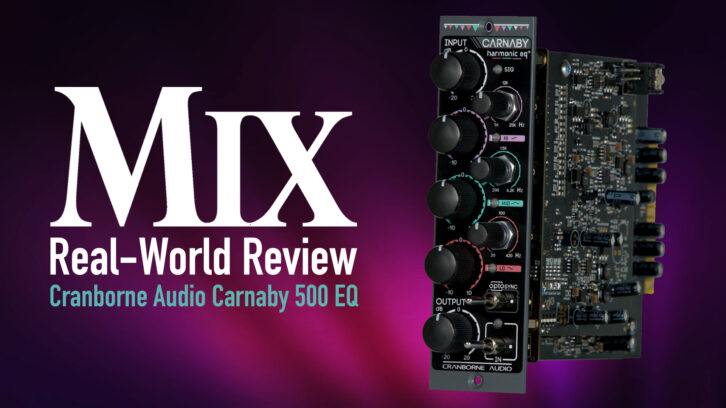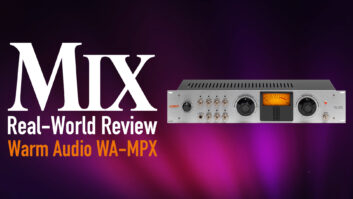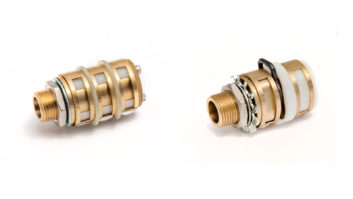
| MIX VERDICT: CRANBORNE AUDIO CARNABY 500 EQ |
| THE TAKEAWAY: “I think the best way to describe it is as something akin to an enhancer—a processor that can sweeten almost any source.” |
| COMPANY: Cranborne Audio • www.cranborne-audio.com PRICE: $499 PROS: • EQ and saturation. • All processing is analog. • Optosync wirelessly connects multiple units. • Band LEDs get brighter with more saturation. • Bands respond dynamically. • Useful on instrument and vocal tracks, buses and full mixes. • Especially impressive on drums. • Affordable. CONS: • Sparse documentation. |
Since releasing its first product, the Camden preamp, in 2019, English manufacturer Cranborne Audio has established a reputation for creating innovative, affordable, analog audio gear. Subsequent products such as the 500R8 500 Series audio interface, 500ADAT expansion unit, and EC1 and EC2 preamps continued that tradition.
Now, the new Carnaby 500 EQ, a single-space 500 Series processor, is Cranborne’s most original product yet. “The world’s first Harmonic EQ” is how the company bills it.
What is harmonic EQ? While a conventional EQ raises or lowers the amplitude of specified frequencies, the Carnaby 500 (named after Carnaby Street, the hub of swinging London back in the 1960s) injects harmonic saturation above the selected frequency to create a boost. When cutting, it adds harmonics above the selected frequency while simultaneously reducing the fundamental. All the processing is strictly analog.
The unit features three semi-parametric bands; that is, each has a frequency-select knob (continuous, not stepped) and a boost/cut control, but no Q adjustment. The Hi and Lo bands are equipped with shelving filters. The Hi ranges from 5 to 25 kHz, with the Lo from 20 to 420 Hz. The Mid band, which has a peaking filter, ranges from 200 Hz to 6.2 kHz.
The EQ bands respond dynamically. The more you boost or cut, the more harmonic saturation is added. The input level also impacts the amount of saturation.
THE LINEUP

Each band has two knobs: a large one for boosting and cutting and a small one for dialing in a frequency. To the right of each level knob is a Band Saturation LED, which glows at different brightness levels to indicate how much saturation is present in that band. According to the Quick Start Guide, the LEDs light after 3 percent THD is measured at the output.
At the top and bottom of the front panel, respectively, are Input and Output knobs. You can turn up the former to get more saturation, and compensate for volume increases with the latter.
You’ll find two small toggle switches on the Carnaby 500. One turns the unit on and off. The other is labeled Optosync, which allows you to link another Carnaby 500 for stereo operation. According to Cranborne, you can sync multiple Carnabys for multichannel mixes.
Device linking for 500 Series gear typically requires a jumper cable from one unit to the next. Optosync works entirely wirelessly. The “Opto” part of its name refers to infrared light sent as a control signal from one unit to the next.
Cranborne lent two Carnabys for the review, so I had the opportunity to test Optosync out. It works flawlessly and entirely in the background. When you flip it on, the power LED on the second Carnaby turns from blue to white, telling you the units are synched. For stereo applications, such as processing an entire mix or aux bus, Optosync is extremely useful. Of course, if you prefer dual- mono, you can leave the Optosync off.
A bank of dip switches on the inside of the Carnaby 500 (accessible only when the unit is not in the frame) allows you to turn on an alternate synching method that requires physically connecting the two units using internal 3.5mm TRS jacks.
Other dip-switchable options include turning on automatic calibration on power-up, keeping the Input control active when the rest of the unit is bypassed, and turning off the band-specific LEDs.
The dip-switch functionality is only cryptically described in the Quick Start Guide, which, currently, is the only documentation for the unit other than a page of sample settings. The Quick Start Guide is helpful, but a little sparse, in my opinion.
You can see all the frequency markings as long as your 500 Series frame is at or a little above eye- level. If you have to look down at it, you won’t be able to read the values at the bottom left of the frequency knobs because the knobs partially hide them. Fortunately, after you familiarize yourself with the unit, you start to memorize the frequency positions for each knob. Of course, you can always use your ears.
TEST DRIVE
After installing the two Carnabys in my Cranborne Audio 500R8 frame, I tried using one on input with various instruments. I connected my electric guitar DI through a UAFX Dream ’65 Reverb pedal into a Camden preamp and then the Carnaby. I was quickly able to dial in boosts and cuts that made an already usable tone livelier and more present. When A/Bing the sound with the processing off and on, I could distinctly hear the softening of the transients from the saturation.
I also recorded a P-Bass going directly into the Camden, then the Carnaby, and was delighted with the results. It fattened the tone up and gave it just a hint of dirt.
I did find that the harmonic EQ wasn’t quite as responsive as a conventional equalizer. I had to boost or cut more than expected to hear the frequency changes I was going for.
Next, I assigned the Carnaby 500s as hardware inserts in my DAW. I used one to add a little sheen to an acoustic guitar track, boosting at 5 kHz and cutting slightly at about 900 Hz and 100 Hz. The harmonics made the low notes sound richer and the upper-mids and highs sparkly. I was also pleased with how it sounded on a mandolin track, where I set it to remove some harshness and soften the transients.
Roswell Pro Audio Aztec – A Mix Real-World Review
The Carnaby is also an excellent vocal processor. Between its frequency adjustments and soft saturation, it can add a little extra polish and oomph to a vocal track and even help bring a dull-sounding one to life.
The most impressive results I got were on drum tracks. Adding heft and warmth to kicks, snares and toms was easy. Linking the two units with Optosync, I got stellar results on full drum mixes and loops.
Finally, I tried the stereo pair on the master bus of several mixes, and the units added a subtle warmth and sheen to the whole mix. If you were in a mastering situation and wanted to inject some analog characteristics, a pair of Carnaby 500s would be a handy option to have in your toolbox.
ORIGINAL SONICS
Many of the analog audio products manufactured today consist of replications of classic products, and I totally get that, but it is refreshing when a company comes up with something new and different. Kudos to Cranborne for breaking the mold.
They didn’t design the Carnaby 500 to be a substitute for a precision EQ or dedicated distortion processor. Their aim was to make a hybrid product with its own character. After using it for a couple of months, I think the best way to describe it is as something akin to an enhancer—a processor that can sweeten almost any source.
Although it’s total speculation, I wouldn’t be at all surprised if Cranborne releases a rackmount version of the Carnaby in the not-too-distant future.







